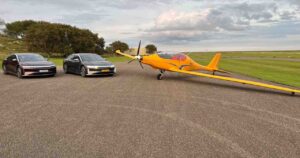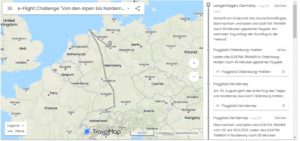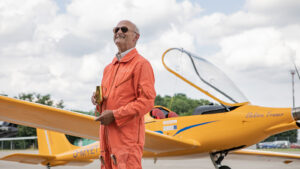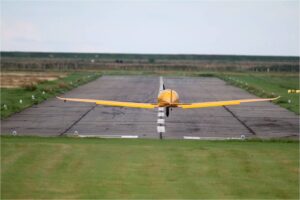A race last week between an Elektra Solar Trainer and a Lucid Air sedan shows the great strides made in electrification for both cars and airplanes.
Electrive.com reports, “A special race went down this week in Germany, setting an electric car against an ultra-light electric aircraft in the ‘E-Flight Challenge 2023.’”

Two Lucid Air sedans and the Elektra Air Trainer at Norderney
This was a relatively high-end affair, as is often true at the onset of new technologies replacing more well-established ones. The Lucid Air sedan comes in several levels of performance and trim, with the least expensive starting at $78,900. The “Pure” rear-wheel drive features a single 480 horsepower motor and is claimed to travel up to 410 miles on a single charge. In all-wheel drive form, it costs $83,900 and manages 384 miles on a single charge of its 92 kilowatt-hour battery. Pures weigh around 2,100 kilograms (4,620 pounds)
A great deal lighter at around 1,332 pounds maximum takeoff weight, the Elektra Solar Trainer flies on a mere 12 kilowatts (16 horsepower) at a cruising speed of 75 mph. Its 35 kilowatt-hour battery should give almost three hours cruising endurance. Both car and aircraft have more than adequate reserve power with the plane’s twin-rotor motor able to produce a maximum 70 kilowatts (93.8 horsepower). The Pure is capable of at least 480 horsepower in its single-motor edition, while other more expensive models for 2024 can produce “north of 1,200 horsepower,” according to Motor Trend.
A 2020 challenge saw a Pipistrel Velis Electro fly a 200-kilometer (124-mile) route in three days with eleven stops. We reported on that flight in this blog, noting that the aircraft was charged at some locations with chargers carried by “chase cars.” This was a common strategy for electric aircraft venturing beyond their home airport boundaries.

A good day out. GPS tracked the car and the aircraft as they traversed much of Germany
According to Electrive, “project partners Elektra Solar (electric aircraft) and Lucid Motors (electric cars) wanted to cover the distance in one day. [Their] Editor’s note: An electric car could have made the route in one day, even in 2020.”
The teams used the slogan “Factor 5 in 3 years” to show how great progress has been in the last three years. Cars and planes have both benefited from improved batteries in that interim.
A press release from Birgit Weißenbach of Elektra Solar GmbH explains, “Now, with our new electric aircraft, Elektra Trainer, we can cover the same route with significantly fewer stops in one day. The flight should start from Memmingen and also end in Norderney.”

Pilot Uwe Nortmann with Elektra Solar Trainer
Bad weather forced a decision to start in Gelnhausen near Frankfurt/Germany instead of Memmingen/Germany. “In the first stage, our Elektra Solar works pilot, Uwe Nortmann, flew more than 200 km. (124 miles) to the NRW gliding performance center in Örlinghausen. “
The aircraft’s batteries were recharged during a press conference (which might have helped reporters understand the airplane’s simplicity of operation). Ms. Weißenbach reports that shortly thereafter, the craft “Went straight to our destination – Norderney Island Airport. After covering 220 km (136 miles), our pilot landed at the destination airport with more than 30-[percent] battery charge.”

Uwe Nortmann landing at Norderney
A day later, Uwe Nortmann flew back to Hannover, with a stopover in Oldenburg-Hatten, made “challenging” by crossing a weather front in “pouring rain and headwind.” The Trainer was further wetted down by a celebratory spray of water from the Hannover Airport fire brigade upon making the field’s first landing of an electric aircraft.
Electrive concludes the story. “In the end, the electric car won but only by a very narrow margin: the Lucid Air arrived on Norderney about half an hour before the Elektra Trainer. The deciding factor was the ferry, which the Air reached three minutes before departure with only a few kilometers remaining range. If the car had missed the ferry to stop for charging (as was required in the strict sense), the plane would probably have taken the race.”
As electric planes become faster and demonstrate more of the performance refined aerodynamics can produce, we will see even greater demonstrations of their capabilities.

